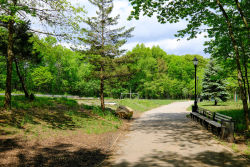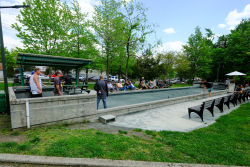Bloomingdale Park
Bloomingdale Park
What was here before?
This site has been preserved as natural parkland. It is home to wildlife including Staten Island’s largest population of box turtles, as well as spring peepers and bullfrogs. The park’s birds include common species such as the Black-capped Chickadee, the Tufted Titmouse, the Northern Cardinal, the White Throat and Song Sparrows, the Junco, the White-eyed Vireo, and migrating warblers.
The park’s woods contain several species of wetland trees native to Staten Island, including swamp white oak, pin oak, sweetgum, and red maple. The upland portion of the park is home to American beech, tulip, aspen, and birch. In addition, both the pitch pine, which is rare for Staten Island, and the Virginia pine, which is rare for New York, grow in a sandy soil area of the park. Other native plants include arrowwood viburnum, mayapple, spicebush, Canada mayflower, and high bush blueberry.
While the area around Bloomingdale Park has developed, the park remains a mostly untouched natural area replete with wildlife, mature woodlands, streams, and wetlands.
How did this become a park?
NYC Parks acquired the first 115.3 acres of this property in 1968 as part of an initiative to protect southern Staten Island’s natural areas from development.
In 2004, after more than ten years of planning and design, 12.5 acres of Bloomingdale Park opened for active recreation. The new facilities, which included a baseball field, three softball fields, a junior soccer field, two basketball courts, bocce courts, and a playground, were designed by landscape architects from the firm of Miceli Kulik Williams who used a series of rustic walkways, wetland boardwalks, and bridges to integrate the site’s manmade and natural elements. The park’s public restroom, designed by the firm Architectonica, employs a natural stone facade to blend into the surroundings.
The park’s first synthetic turf soccer field opened in 2008. This field was upgraded in 2020 when a second synthetic turf field was added, in addition to new pathways connecting the fields.
What is this park named for?
Initially referred to as “the property adjacent to Bloomingdale Road,” over time Bloomingdale Park became its official name for its location beside the thoroughfare.
Check out your park's Vital Signs
Clean & Safe
Green & Resilient
Empowered & Engaged Users
Share your feedback or learn more about how this park is part of a
Vital Park System










